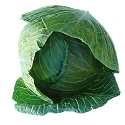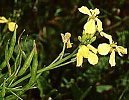|
Family: Brassicaceae or Cruciferae (Cabbage, Turnip, Caper family)
Life
> eukaryotes >
Archaeoplastida >
Chloroplastida
>
Charophyta > Streptophytina > Plantae (land plants)
> Tracheophyta (vascular plants) > Euphyllophyta > Lignophyta (woody plants)
> Spermatophyta (seed plants) > Angiospermae (flowering
plants) > Eudicotyledons > Core Eudicots > Rosids >
Eurosid II > Order: Brassicales
There are about 338 genera and 3710 species of Brassicaceae worldwide, with
nine genera and 117 species native to southern Africa, an additional 22 genera
and 41 species are naturalised, and an additional 15 genera and 42 species are
cultivated in the region. Capparaceae and Cleomaceae are placed under Brassicaceae in some
classifications but they are kept as three families here (following
Angiosperm
Phylogeny website Version 9).
Genera native to southern Africa
List from Dreyer & Jordaan (2000a, b) and
Plants
of Southern Africa - an Online Checklist (SANBI).
Aplanodes Two species,
both endemic to southern Africa |
|
Cardamine
(bittercresses) About 130
species, found worldwide. In southern Africa there are two native species
and three naturalised. |
|
Chamira The single
species, Chamira circaeoides, is endemic to the Western Cape. |
|
Erucastrum About 18
species, native to central and southern Europe, Arabian Peninsula and
Africa, with three species native to southern Africa. |
|
Heliophila
Eighty-one
species, all endemic to southern Africa, mainly winter-rainfall regions. |
|
Lepidium About 150
species, widely distributed in temperate and subtropical regions of the
world, with 16 native and two naturalised species in southern Africa. One of
the latter, Lepidium draba (Pepper-cress,
Hoary cardaria, White top, Peperbos) is a
declared Category 1 invasive plant
in South Africa. In addition to these native and naturalised species,
Lepidium sativum (Garden cress) is cultivated in southern
Africa. |
|
Matthiola
(stocks) About 55 species, native to Macronesia, western
Europe, the Mediterranean region and also southern Africa where
there is one native species. In addition, two species have become
naturalised, and a further two are cultivated, in southern Africa. |
|
Rorippa
About 80 species, widely distributed mainly in
temperate regions. Six species are native to southern Africa and
one species,
Rorippa
nasturtium-aquaticum (Watercress)
is naturalised in the region. |
|
Sisymbrium About 80 species, native to Eurasia, the
Mediterranean region, Africa and South America. Five species are native
to southern Africa, three are naturalised, and a further species is
cultivated in the region. |
|
Genera naturalised in southern Africa
List from Dreyer & Jordaan (2000a, b).
Alyssum About 168
species, native mainly to the Mediterranean region but also found in
central Europe and Asia. Alyssum minutum has become naturalised in
southern Africa (Namaqualand and Western Cape). A further five species are
cultivated in the region. Sweet Alyssum, the garden
plant with little white flowers that is grown commonly along borders of
flower beds, is no longer placed in this genus and is now known as
Lobularia
maritima. |
|
Arabidopsis A total of
13 species, native to Asia, Europe and North America.
Arabidopsis
thaliana (Thale cress) has become naturalised in southern Africa (Northern, Western
and Eastern Cape). |
|
Barbarea The 12 species
are native to Europe, North America and N Asia.
Barbarea verna (Land cress)
has
become naturalised in southern Africa (Western Cape). In addition,
Barbarea vulgaris (Yellow rocket) (native to Eurasia and North Africa) is cultivated in the region. |
|
Brassica About 40
species, native mainly to Eurasia. Five species have become naturalised in
southern Africa. An additional three species are cultivated in the region. This genus includes some important species used as
vegetables, herbs and spices:
Brassica
rapa (Turnip, Rapes,
Mustards, Oriental Cabbages);
Brassica juncea (Indian or Brown Mustard); Brassica nigra (Black Mustard); and Brassica oleracea
(Cabbage, Brussels Sprouts, Broccoli, Kohlrabi, Cauliflower, Kale). |

|
Camelina About 10
species, native to central Europe, eastern Mediterranean and central Asia.
Cultivated widely for fibre, bird seed and seed oil (cameline oil). One
species Camelina rumelica naturalised in southern Africa (Gauteng). |
|
Capsella Five
species, native to eastern Mediterranean and W Asia.
Capsella
bursa-pastoris (Shepherd's Purse) is naturalised in southern Africa. See
Flora of Zimbabwe. |
|
Carrichtera One
species occurs as a rare escape in Harare, Zimbabwe - Carrichtera annua. |
|
Coronopus
Ten species, native to the Mediterranean region, southeast Africa and South
America. There are three naturalised species in southern Africa. |
|
Crambe About 20 species,
native to W Asia, central Europe, the Mediterranean region and northern
tropical Africa. Crambe hispanica (native from Portugal to Greece) has become naturalised in
southern Africa (KwaZulu-Natal). |
|
Descurainia About 55
species, mainly occurring in North America but also native to South
America, Europe and Asia. Descurainia sophia has become locally
naturalised in arid areas of southern Africa (Gauteng, Northern and
Eastern Cape). |
|
Diplotaxis About 27
species, native to Mediterranean region and central Europe, extending
eastwards to India. Diplotaxis muralis (Wall rocket) has become naturalised in
southern Africa. See
Wikipedia |
|
Eruca The five species are
native to the Mediterranean region. Eruca vesicaria subsp. sativa
(Rocket, Salad rocket) has become
naturalised in the northern summer-rainfall regions and is cultivated as a
vegetable that is used in salads. Eruca vesicaria subsp. vesicaria
is also cultivated in southern Africa. |
|
Hirschfeldia The
two species
are native to the Mediterranean and Socotra. Hirschfeldia incana has been
introduced to the Western Cape where it has been recorded as an escape
from cultivation. |
|
Hutchinsia
Hutchinsia procumbens (Oval purse) [= Hymenolobus procumbens,
Hornungia procumbens] has been recorded as an escape from
cultivation in the Western Cape. Depending on the authority, this species
can be found under three different genus names, which is very confusing.
Hutchinsia is used by
Encyclopedia of
Life. |
|
Hymenolobus One
species is naturalised in southern Africa: Hymenolobus procumbens. |
|
Lobularia Five species, native to Cape Verde, Canary Islands and the
Mediterranean region. Lobularia maritima (Sweet
alyssum, Sweet
alison) has escaped from cultivation in the Western Cape. See
Flora of Zimbabwe. |

|
Nasturtium One
species is naturalised in southern Africa: Nasturtium officinale. |
|
Raphanus
(Radish
genus)
About eight species, native to western and central
Europe. Raphanus raphanistrum (Wild Radish) and Raphanus
sativus (Radish) are
naturalised in southern Africa. The red, fleshy taproot of Radish is eaten
as a vegetable, although the peppery taste is not to everyone's liking. |

|
Rapistrum Three species,
native to central Europe, the Mediterranean region and western Asia. Rapistrum
rugosum (Turnip weed) is naturalised in southern Africa. |
|
Sinapis About 10
species, native to the Mediterranean region but now widespread in Europe. Sinapis
arvensis (Wild mustard, Charlock) and Sinapis alba
(White mustard) are weeds associated with cultivation
in southern Africa. |
|
Thlaspi About 60
species, native to temperate regions of the northern hemisphere. Thlaspi
arvense (Field penny-cress) has become naturalised in southern Africa (Eastern Cape).
In addition, Thlaspi alpinum (native to central Europe) is cultivated
in the region. |
|
Turritis Three species,
native to Europe, western Asia and Africa. Turritis glabra is
naturalised in southern Africa. |
|
Other genera, cultivated in
southern Africa
List from Glen (2002). Species are listed for genera
represented by only one species in southern Africa.
Aubrieta The
genus has been cultivated in southern Africa but no particular species is
listed in Glen (2002). See
Wikipedia |
|
Aethionema (stonecresses)
Two species cultivated: Aethionema grandiflorum (native to
southwestern Asia) and Aethionema saxatile (native to the
Mediterranean). |
|
Arabis
Six species cultivated. |
|
|
Armoracia rusticana (Horseradish)
A pungent herb with leaves that are used in salads and
sandwiches, and roots that are used for sauces that are added to meat. It is
also used for various medical complaints. It is native to southern Russia
and Eastern Ukraine. It has become naturalised in Europe, North America and
New Zealand, where it can be found growing along roadsides. Cultivation
dates back only to about Roman and Greek times, about 2000 years ago. |
|
Aurinia saxatilis (Basket of gold)
Native to central and eastern Europe. See
Wikipedia |
|
Cochlearia officinalis (Scurvy
grass) Native to central and northwestern Europe. See
Skye Flora |
|
Draba
(whitlow-grasses) About 300 species, native to north
temperate and boreal regions and also to South American mountains. Three
species are cultivated in southern Africa. |
|
Erysimum
(wallflowers) About 225 species, native to southwestern
Asia, the Mediterranean, Europe, Macronesia, North America and Central
America as far south as Costa Rica. Three species are cultivated in southern
Africa. |
|
Fibigia clypeata
Native from Italy to the Crimea. |
|
Hesperis laciniata
Native to the south Balkans. |
|
Hornungia alpina
Native to central and southern Europe. See
Wikipedia |
|
Iberis
(candytufts) About 30 species, native to Europe. Three
species are cultivated in southern African gardens. |
|
Isatis tinctoria (Woad)
Native to southwestern Asia. Woad was the only source of indigo dye (the
chemical compound is called indican) in Europe until about the end of the
16th century when indigo from Indigofera tinctoria and other
Indigofera species started
being imported from the East. See Wikipedia on the
plant and the
dye. |
|
Lunaria Two
species cultivated as ornamental plants: Lunaria annua (Annual
honesty, Honesty) (see
Wikipedia) and Lunaria rediviva (Perennial honesty) (see
Wikipedia) |
|
Malcolmia maritima (Virginia
stocks) Native to Greece and Albania. See
Wikipedia |
|
Publications
-
Dreyer, L.L. & Jordaan, M. 2000b.
Brassicaceae. In: Seed Plants of
Southern Africa (ed. O.A. Leistner). Strelitzia 10: 184-191.
National Botanical Institute, Pretoria.
-
Glen, H.F. 2002. Cultivated Plants of
Southern Africa. Jacana, Johannesburg.
|
